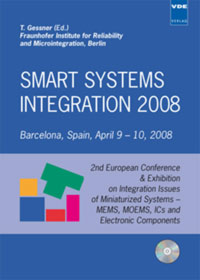MEMS based inertial measurement unit for attitude and heading reference systems
Conference: Smart Systems Integration 2008 - 2nd European Conference & Exhibition on Integration Issues of Miniaturized Systems - MOMS, MOEMS, ICS and Electronic Components
04/09/2008 - 04/10/2008 at Barcelona, Spain
Proceedings: Smart Systems Integration 2008
Pages: 8Language: englishTyp: PDF
Personal VDE Members are entitled to a 10% discount on this title
Authors:
Bartholomeycz, J.; Zimmermann, S.; Breng, U.; Gutmann, W.; Hafen, M.; Handrich, E.; Huber, M.; Kempfer, U.; Kopmann, H.; Kunz, J.; Leinfelder, P.; Ohmberger, R.; Probst, U.; Ruf, M.; Spahlinger, G.; Rasch, A.; Straub-Kalthoff, J.; Stroda, M.; Stumpf, K.; Weber, C.; Zimmermann, M.; Geiger, W. (LITEF GmbH, Freiburg)
Abstract:
Attitude and heading reference systems (AHRS) provide pitch and roll angles relative to the earth gravity vector, and heading (azimuth) angle relative to north. Such systems are critical for aircraft that fly during darkness or under other conditions of reduced visibility. AHRS systems require an inertial measurement unit (IMU) capable of measuring angular rate and acceleration in three orthogonal axes. Magnetometer augmentation may be employed to improve long term stability. To date, angular rate measurement is typically realized using mechanical, fiber-optic or ring laser gyroscopes. While all three technologies are capable of providing the performance required for AHRS systems, they all have limitations in realizing low production cost solutions. In contrast Micro-Electro-Mechanical Systems (MEMS), produced using batch processes, have the potential to substantially lower the cost of an AHRS system. For more than a decade MEMS sensors capable of measuring acceleration and angular rate have been very common in many other fields of application such as automotive safety systems and consumer electronics. However, while MEMS accelerometers have been successfully used in AHRS systems this field has to date remained a challenge for MEMS gyroscopes. AHRS utilizing MEMS gyros have been presented and are commercially available. To our knowledge none of these systems have been qualified according to the Federal Aviation Administration (FAA) Technical Standard Order C5e (TSOC5e) for the directional gyro (DG) mode of operation. Such MEMS AHRS typically require the addition of a magnetometer to ensure the required long term stability. DG mode is required for many applications including large commercial aircraft, flights close to the magnetic north pole and helicopter flights to and from oil rigs or other large metal structures. IMUs used for DG mode operation require that the overall error should not exceed 5 °/h. In contrast, typical automotive sensors are specified in degrees per second. AHRS accelerometers require an overall error not exceeding 2.5 mg.


